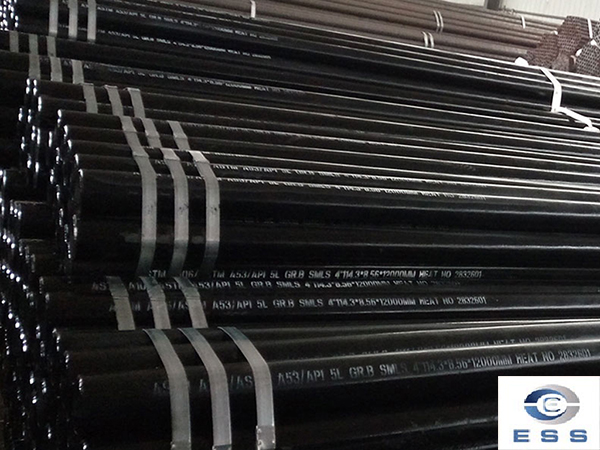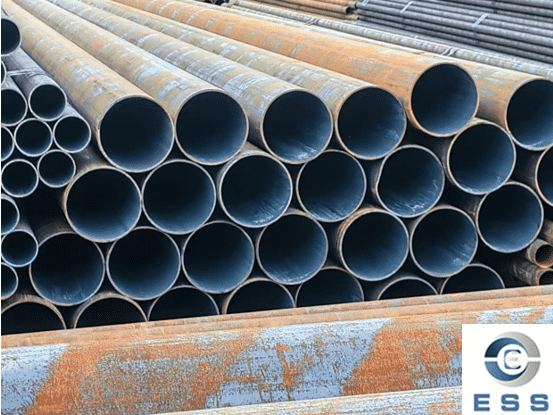Surface quality of seamless carbon steel pipes
This standard specifies the requirements for a "smooth surface" on steel pipes. However, due to various reasons during the production process, there are as many as 10 kinds of surface defects in steel pipes. Includes: surface cracks (cracks), hair lines, inner creases, outer creases, punctures, inner straights, outer straights, separations, scars, pits, convex bumps, pits (pits), scratches (scratches) , inner spiral, outer spiral, blue line, concave correction, roll printing, etc. The causes of these defects are mainly surface defects or internal defects of the tube blank. On the other hand, it occurs during the production process that the design of rolling process parameters is unreasonable, the surface of the tool (mold) is not smooth, the lubrication conditions are not good, the hole design and adjustment are unreasonable, etc. Unreasonable conditions, etc. may lead to problems with steel pipes. Surface quality problems; or during the heating, rolling, heat treatment, and straightening processes of steel billets (steel pipes), if the heating temperature is improperly controlled, uneven deformation, unreasonable heating and cooling rates, or excessive straightening deformation will result. Excessive residual stress may also cause surface cracks in the steel pipe.

Factors affecting the performance of seamless carbon steel pipes
1. Chemical composition of steel
The chemical composition of steel is the most important factor affecting the performance of seamless carbon steel pipes. It is also the main basis for formulating steel pipe rolling process parameters and steel pipe heat treatment process parameters. In the seamless carbon steel pipe standard, according to the different uses of the steel pipe, corresponding requirements are put forward for the smelting of the steel and the manufacturing method of the pipe blank, and strict regulations are made on the chemical composition. In particular, requirements are put forward for the content of certain harmful chemical elements (arsenic, tin, antimony, lead, bismuth) and gases (nitrogen, hydrogen, oxygen, etc.). In order to improve the uniformity of the chemical composition of the steel and the purity of the steel, reduce non-metallic inclusions in the steel billet and improve their distribution, refining equipment outside the furnace is often used to refine the molten steel, and even electroslag furnaces are used to regenerate steel billets. Smelting.
2. Steel pipe geometric accuracy and outer diameter
Steel pipe outer diameter accuracy, wall thickness, ovality, length, steel pipe curvature, steel pipe end cut slope, steel pipe end bevel and blunt edge, special-shaped steel pipe cross-sectional dimensions
3. Steel pipe outer diameter accuracy
The outer diameter accuracy of seamless carbon steel pipes depends on the method of determining (reducing) the diameter (including tension reduction), the operation of the equipment and the process system. And the accuracy of the outer diameter is also related to the processing accuracy of the hole shape of the fixed (reducing) diameter machine and the distribution and adjustment of the deformation of each frame. The outer diameter accuracy of cold-rolled (抜) formed seamless carbon steel pipes is related to the accuracy of the mold or rolling passes.
4. Chamber wall thickness
The wall thickness accuracy of seamless carbon steel pipes is related to the heating quality of the tube blank, the process design parameters and adjustment parameters of each deformation process, the quality of the cutting tools and their lubrication quality. Uneven wall thickness distribution of steel pipes refers to uneven transverse wall thickness and uneven longitudinal wall thickness.
5.Steel management performance
The physical and chemical properties of steel pipes include mechanical properties at room temperature, mechanical properties at a certain temperature (thermal strength performance or low temperature performance) and corrosion resistance (oxidation resistance, water corrosion resistance, acid and alkali resistance, etc.). Generally speaking, the physical and chemical properties of steel pipes mainly depend on the chemical composition of the steel, the structure of the steel, the purity of the steel and the heat treatment method of the steel pipe. Of course, in some cases, the rolling temperature and deformation system of the steel pipe will also affect the performance of the steel pipe.
6. Steel pipe metallographic structure
The metallographic structure of the steel pipe includes the low-magnification structure and the high-magnification structure of the steel pipe.
7.Special requirements for steel pipes
Special conditions required by customers.
Stabilization, welding and corrosion protection of seamless carbon steel pipes
Stabilizing pipes means stabilizing the pipes to the foundation or foundation according to the design markings and horizontal position. The pipe should be placed in the center of the trench, and its allowable deviation should not be greater than 100mm. The pipeline should be firmly placed in the trench, and there should be no hanging objects below the pipeline to prevent the pipeline from bearing additional stress.
If there is a position error in the pre-dug welding work pit, it should be re-excavated according to actual needs. When digging, the anti-corrosion layer of the pipeline must not be damaged. The soil and debris in the pipe should be removed before the pipe interface. When butt welding is performed in the trench, the gap and misalignment of the butt joints should meet the requirements, and the pipes should remain straight. Dirt and rust on both sides of the weld should be removed before welding.
After the pipeline is welded, a comprehensive inspection must be carried out with an electric spark leak detector before backfilling, and the spark breakdown must be repaired. Urban gas pipelines should comply with relevant standards. Repairs that do not meet the requirements will be inspected again until they pass.
After the pipe group is welded, non-destructive testing of the welds and strength and tightness testing of the pipes are required. After passing the test, the welds should be treated with anti-corrosion treatment. After passing the electric spark inspection, all the soil can be backfilled. Usually, after the pipeline is welded, a welding pit is reserved, and the pipe body is filled with soil to cover the pipe body to prevent stones and other hard objects from falling on the pipe and damaging the anti-corrosion layer. , and at the same time can reduce the impact of temperature changes on the pipeline. The thermal expansion and contraction of the anti-corrosion layer will cause damage to the anti-corrosion layer due to friction with the soil.
The horizontal and vertical gaps between underground gas pipelines and buildings, structures or adjacent pipes and cables. If it is difficult to arrange due to terrain restrictions and cannot be solved, the clear distance can be appropriately shortened after taking effective protective measures together with relevant departments.
When gas pipelines encounter obstacles, the following measures are often taken:
(1) When the actual situation is smaller than the specified net distance, the gas pipeline can be bypassed horizontally or vertically according to local conditions, and 4 additional elbows can be added.
(2) Add casing and lay the gas pipeline inside the casing.
(3) Add a ditch and lay the gas pipe in the brick pipe ditch.













 Eastern Steel Manufacturing Co.,Ltd not only improve product production and sales services, but also provide additional value-added services. As long as you need, we can complete your specific needs together.
Eastern Steel Manufacturing Co.,Ltd not only improve product production and sales services, but also provide additional value-added services. As long as you need, we can complete your specific needs together.










